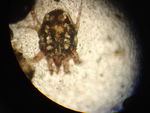Difference between revisions of "Psoroptes ovis"
| (21 intermediate revisions by 3 users not shown) | |||
| Line 1: | Line 1: | ||
| − | { | + | {| cellpadding="10" cellspacing="0" border="1" |
| − | + | | Predilection site | |
| − | | | + | | '''Skin'''; particularly on legs, feet, and the base of the tail. |
| − | + | |- | |
| − | + | |} | |
| − | |||
| − | | | ||
| − | | | ||
| − | | | ||
| − | |||
| − | |||
| − | |||
| − | | | ||
| − | } | ||
| − | |||
| − | ==Introduction== | + | ===Introduction=== |
| − | |||
| − | + | ''Psoroptes ovis'' are astigmatic, non-burrowing mites around 750μm (0.75mm) in length, and oval shaped. They are extremely pruritic, and cause a contagious skin disease, as well as a loss in body condition. They also cause the host to rub and bite the infected areas, resulting in further trauma. | |
| − | + | ===Hosts=== | |
| − | |||
| − | ==Hosts== | ||
Sheep, cattle, goats, horses, rabbits, and camelids. | Sheep, cattle, goats, horses, rabbits, and camelids. | ||
| − | == | + | ===Life Cycle=== |
| − | The | + | The eggs are relatively large, and within around 2 days transform into a hexapod larva. The larvae then moult into a protonymph , which then subsequently moults into a tritonymph. Finally the tritonymph moults to become a mature adult. |
| − | |||
| − | + | Each stage takes around 2 days to complete. The total duration from egg to adult, takes around 10 days, but this figure can longer. | |
| − | + | Transmission is generally from direct contact with infected animals, but indirect transmission mau also occur. | |
| − | |||
| − | + | [[Image:Psoroptes cuniculi.jpg|150px|thumb|right|'''Psoroptes cuniculi (Copyright Joel Mills, Wikimedia Commons) ''']] | |
| − | |||
| − | + | ===Identification=== | |
| + | The adault ''Psoroptes'' are around 0.75mm in length and oval in shape. | ||
| + | They have three-jointed pedicles, each with suckers on the ends; also known as pulvilli. | ||
| − | + | The legs of adult females are all approximately the same length. However, in the males the fourth pair of legs is significantly shorter than the rest. The males also tend to be smaller then the females. | |
| − | + | The males may also be identified via copulatory suckers and paired posterior lobes. | |
| − | + | The males attach to deutonymphs (second moult after larval stage) in a process called '''copula'''. The males then remain in copula until the females moult for the final time. Copulation then occurs | |
| − | |||
| − | |||
| − | |||
| − | |||
| − | |||
| − | |||
| − | |||
| − | |||
| − | |||
| − | |||
| − | |||
| − | |||
| − | [[Category: | + | [[Category:Sheep]][[Category:Cattle]] |
| + | [[Category:To_Do_-_Max]] | ||
Revision as of 09:33, 13 July 2010
| Predilection site | Skin; particularly on legs, feet, and the base of the tail. |
Introduction
Psoroptes ovis are astigmatic, non-burrowing mites around 750μm (0.75mm) in length, and oval shaped. They are extremely pruritic, and cause a contagious skin disease, as well as a loss in body condition. They also cause the host to rub and bite the infected areas, resulting in further trauma.
Hosts
Sheep, cattle, goats, horses, rabbits, and camelids.
Life Cycle
The eggs are relatively large, and within around 2 days transform into a hexapod larva. The larvae then moult into a protonymph , which then subsequently moults into a tritonymph. Finally the tritonymph moults to become a mature adult.
Each stage takes around 2 days to complete. The total duration from egg to adult, takes around 10 days, but this figure can longer.
Transmission is generally from direct contact with infected animals, but indirect transmission mau also occur.
Identification
The adault Psoroptes are around 0.75mm in length and oval in shape. They have three-jointed pedicles, each with suckers on the ends; also known as pulvilli.
The legs of adult females are all approximately the same length. However, in the males the fourth pair of legs is significantly shorter than the rest. The males also tend to be smaller then the females.
The males may also be identified via copulatory suckers and paired posterior lobes. The males attach to deutonymphs (second moult after larval stage) in a process called copula. The males then remain in copula until the females moult for the final time. Copulation then occurs
